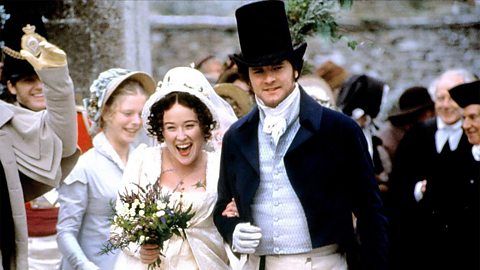Key points
For Edexcel, Pride and Prejudice is assessed on Paper 2: the 19th-century Novel and poetry since 1789.
You will be presented with one extract and a two-part question.
Part (a) of the question will ask you to analyse the language in an extract. Part (b) will ask you to explore ideas from the rest of the novel.
This is a closed book exam, which means you will not be allowed to have a copy of the novel with you.

МэМэМэМэМэМэ
Remember
The more time you spend planning your answers and practising writing within the time limit as part of your revision, the more confident you will feel in the final exam.
GCSE exam-style question
Planning your answer
It is a good idea to spend a few minutes planning your answer before you start writing.
You should identify the key words and plan out some of your main points.
For part (a), you should annotateAdd notes with some explanation or comment. the extract to help shape your argument.
You could plan using bullet points or a mind-map, or any other way that you find useful.

Example question
(a) Explore how Austen presents Elizabeth and DarcyвҖҷs relationship in this extract.
(b) In this extract, Darcy and Elizabeth are both stubborn and proud. Explain how pride is important elsewhere in the novel.
In this extract from Volume 2 Chapter 11, Darcy proposes marriage to Elizabeth for the first time.
Click below to open the extract
After a silence of several minutes, he came towards her in an agitated manner, and thus began:
вҖңIn vain have I struggled. It will not do. My feelings will not be repressed. You must allow me to tell you how ardently I admire and love you.вҖқ
·ЎұфҫұіъІ№ІъұріЩіувҖҷs astonishment was beyond expression. She stared, colouredIn this context, it means that she blushed., doubted, and was silent. This he considered sufficient encouragement, and the avowalWhen you say or admit something that you believe, support, or plan to do. of all that he felt and had long felt for her immediately followed. He spoke well; but there were feelings besides those of the heart to be detailed, and he was not more eloquent on the subject of tenderness than of pride. His sense of her inferiority, of it being a degradationWhen the beauty or quality of something is spoiled or destroyed., of the family obstacles which judgment had always opposed to inclination, were dwelt on with a warmth which seemed due to the consequence he was wounding, but was very unlikely to recommend his suitIn this context, the act of pursuing someone romantically..
In spite of her deeply-rooted dislike, she could not be insensible to the compliment of such a manвҖҷs affection, and though her intentions did not vary for an instant, she was at first sorry for the pain he was to receive; till roused to resentmentA mixture of disappointment, disgust and anger. by his subsequent language, she lost all compassion in anger. She tried, however, to compose herself to answer him with patience, when he should have done. He concluded with representing to her the strength of that attachment which in spite of all his endeavours he had found impossible to conquer; and with expressing his hope that it would now be rewarded by her acceptance of his hand. As he said this she could easily see that he had no doubt of a favourable answer. He spoke of apprehension and anxiety, but his countenance expressed real security. Such a circumstance could only exasperate farther; and when he ceased the colour rose into her cheeks and she said:
вҖңIn such cases as this, it is, I believe, the established mode to express a sense of obligation for the sentiments avowed, however unequally they may be returned. It is natural that obligation should be felt, and if I could feel gratitude, I would now thank you. But I cannotвҖ”I have never desired your good opinion, and you have certainly bestowed it most unwillingly. I am sorry to have occasioned pain to anyone. It has been most unconsciously done, however, and I hope will be of short duration. The feelings which you tell me have long prevented the acknowledgment of your regard can have little difficulty in overcoming it after this explanation.вҖқ
Mr. Darcy, who was leaning against the mantelpiece with his eyes fixed on her face, seemed to catch her words with no less resentment than surprise. His complexion became pale with anger, and the disturbance of his mind was visible in every feature.

МэМэМэМэМэМэ
Exam top tip
For Part (a), you must focus on the extract you are given.
Inspecting the question
Before you start writing your answer, make sure you understand the question properly by asking yourself:
1. What are the key words in the questions?
- вҖҳeіжұиұфҙЗ°щұрвҖҷ вҖ“ this word is reminding you to think about a range of ideas from the whole of the novel to answer the question.
- вҖҳhҙЗ·ЙвҖҷ вҖ“ this word asks you to look at the writerвҖҷs choice of language and techniques. What tools have they used?
- вҖҳElizabeth and DarcyвҖҷs relationshipвҖҷ вҖ“ the question focuses on just these two characters and how they interact with one another.
- вҖҳp°щұрІхұрІФіЩІхвҖҷ вҖ“ remember, the characters and the relationship are created by Austen. What ideas is she trying to express or show us through Elizabeth and DarcyвҖҷs relationship?
- вҖҳp°щҫұ»еұрвҖҷ вҖ“ this is a recurringHappening or appearing more than once. theme in the novel. What examples of characters showing pride can you think of?
2. What are some important moments to analyse in the extract?
You might choose to write about:
- DarcyвҖҷs nervousness at the start (вҖҳagitated mannerвҖҷ)
- DarcyвҖҷs demand that he be heard (вҖңYou must allow me to tell youвҖқ)
- DarcyвҖҷs feelings towards Elizabeth (вҖңhow ardently I admire youвҖқ)
- The narratorвҖҷs description of ·ЎұфҫұіъІ№ІъұріЩіувҖҷs shock (вҖҳShe stared, coloured, doubtedвҖҷ)
- ·ЎұфҫұіъІ№ІъұріЩіувҖҷs feeling of pity (вҖҳshe was at first sorry for the pain he was about to receiveвҖҷ)
- ·ЎұфҫұіъІ№ІъұріЩіувҖҷs change to anger (вҖҳshe lost all compassionвҖҷ)
- ·ЎұфҫұіъІ№ІъұріЩіувҖҷs firm and direct rejection (вҖңI have never desired your good opinionвҖқ)
- DarcyвҖҷs shock at his rejection (вҖҳthe disturbance of his mindвҖҷ).
3. What important examples of pride are there in the novel?
You might choose to write about:
- DarcyвҖҷs refusal to dance with Elizabeth at Meryton, and the Bennet sistersвҖҷ response to this
- Darcy hiding his changing feelings towards Elizabeth when she is caring for Jane at Netherfield
- ·ЎұфҫұіъІ№ІъұріЩіувҖҷs reluctanceNot wanting to do something. to admit that her first impressions of both Wickham and Darcy were wrong
- ҙіІ№ІФұрвҖҷs reluctanceNot wanting to do something. to find out why BingleyвҖҷs feelings towards her may have changed
- Mr CollinsвҖҷ repeated boasts about his connections to wealthy people
- The contrast between DarcyвҖҷs attitude in his first marriage proposal and his second
- іўІв»еҫұІ№вҖҷs defiantResisting or refusing to obey. return to Longbourn after marrying Wickham
- ·ЎұфҫұіъІ№ІъұріЩіувҖҷs refusal to capitulateTo give in or agree to do something unwillingly. to Lady CatherineвҖҷs demand that she should not marry Darcy.
Assessment objectives
Your exam response will be marked using Assessment Objectives. The ones for this question are below.
| What is the objective? | How do I do well? |
|---|---|
| AO1: the quality of your ideas, understanding of the text and use of supporting evidence. | Stay focused on the question and show that you understand the text and the writerвҖҷs messages well. Use evidence clearly and carefully to support your answer. |
| AO2: analysis of the writerвҖҷs methods and effects. | Explain how the writer uses different tools to create meaning. Use the correct language to explain these techniques and their effects on the audience. |
Identifying AO1 and AO2
In the exam, Part (a) is only assessed on AO2, and Part (b) is only assessed on AO1. Although there is some overlap, you will need to be clear what each AO is asking you to do.
Activity
Structuring your answer
At the start of your answers, it is helpful to have a short introduction.
An effective introduction should give a summary of the ideas you are about to present, and link to the question and the writerвҖҷs message.
After your introduction, each paragraph should include:
- A topic sentence, which uses some of the language of the question, to introduce your argument
- Evidence that supports your argument
- Analysis of the effects of language techniques
- A final sentence that acts as a mini-summary.
An awareness of the writerвҖҷs purpose is important.
In the Edexcel exam you will not be awarded marks for making points about context, so you should focus your answer on ideas and methods.
You could include a short conclusion that summarises the key ideas in your answer.
Example answers
Read and compare these two sample answers to the question:
(a) Explore how Austen presents Elizabeth and DarcyвҖҷs relationship in this extract.
(b) In this extract, Darcy and Elizabeth are both stubborn and proud. Explain how pride is important elsewhere in the novel.
In this extract from Volume 2 Chapter 11, Darcy proposes marriage to Elizabeth for the first time.
Click below to open the extract
After a silence of several minutes, he came towards her in an agitated manner, and thus began:
вҖңIn vain have I struggled. It will not do. My feelings will not be repressed. You must allow me to tell you how ardently I admire and love you.вҖқ
·ЎұфҫұіъІ№ІъұріЩіувҖҷs astonishment was beyond expression. She stared, colouredIn this context, it means that she blushed., doubted, and was silent. This he considered sufficient encouragement, and the avowalWhen you say or admit something that you believe, support, or plan to do. of all that he felt and had long felt for her immediately followed. He spoke well; but there were feelings besides those of the heart to be detailed, and he was not more eloquent on the subject of tenderness than of pride. His sense of her inferiority, of it being a degradationWhen the beauty or quality of something is spoiled or destroyed., of the family obstacles which judgment had always opposed to inclination, were dwelt on with a warmth which seemed due to the consequence he was wounding, but was very unlikely to recommend his suitIn this context, the act of pursuing someone romantically..
In spite of her deeply-rooted dislike, she could not be insensible to the compliment of such a manвҖҷs affection, and though her intentions did not vary for an instant, she was at first sorry for the pain he was to receive; till roused to resentmentA mixture of disappointment, disgust and anger. by his subsequent language, she lost all compassion in anger. She tried, however, to compose herself to answer him with patience, when he should have done. He concluded with representing to her the strength of that attachment which in spite of all his endeavours he had found impossible to conquer; and with expressing his hope that it would now be rewarded by her acceptance of his hand. As he said this she could easily see that he had no doubt of a favourable answer. He spoke of apprehension and anxiety, but his countenance expressed real security. Such a circumstance could only exasperate farther; and when he ceased the colour rose into her cheeks and she said:
вҖңIn such cases as this, it is, I believe, the established mode to express a sense of obligation for the sentiments avowed, however unequally they may be returned. It is natural that obligation should be felt, and if I could feel gratitude, I would now thank you. But I cannotвҖ”I have never desired your good opinion, and you have certainly bestowed it most unwillingly. I am sorry to have occasioned pain to anyone. It has been most unconsciously done, however, and I hope will be of short duration. The feelings which you tell me have long prevented the acknowledgment of your regard can have little difficulty in overcoming it after this explanation.вҖқ
Mr. Darcy, who was leaning against the mantelpiece with his eyes fixed on her face, seemed to catch her words with no less resentment than surprise. His complexion became pale with anger, and the disturbance of his mind was visible in every feature.
Part (a)
Example answer 1

Answers could include:
In the extract, Darcy is focused on himself and not Elizabeth. He starts off as very nervous. Austen uses the word вҖҳagitatedвҖҷ to show that he is not behaving as he normally would. Trying to take control of the situation, he uses imperative language: вҖңYou must allow me to tell youвҖқ, as though he is interrupting Elizabeth, even though she is already listening. This command has the effect of placing the reader on ·ЎұфҫұіъІ№ІъұріЩіувҖҷs side because of DarcyвҖҷs rudeness.
As the extract goes on, ·ЎұфҫұіъІ№ІъұріЩіувҖҷs feelings towards Darcy are changing. Austen describes ·ЎұфҫұіъІ№ІъұріЩіувҖҷs shock using a list of three: вҖҳstared, coloured, doubtedвҖҷ. This shows that Elizabeth is having both a physical and emotional response to what Darcy is saying, but she stays silent. However, as Darcy goes on this turns to anger and вҖҳshe lost all compassionвҖҷ. The word вҖҳallвҖҷ shows how quickly her feelings have changed towards him in a very direct way.
At the end of the extract, it is obvious that Darcy and ·ЎұфҫұіъІ№ІъұріЩіувҖҷs relationship is in a challenging place. Elizabeth saying that she has вҖңnever desiredвҖқ DarcyвҖҷs good opinion implies how strongly she dislikes him, with the adverb вҖҳneverвҖҷ reminding the reader of how badly Darcy treated Elizabeth at the start of the novel. At the same time, Darcy is shocked at ·ЎұфҫұіъІ№ІъұріЩіувҖҷs response, which proves that he does not really know her. The description of the вҖҳdisturbance of his mindвҖҷ shows how deeply and intensely surprised he is by how much he has misunderstood their relationship.
Feedback
- There is good focus on the question and the language, structure and form used.
- The answer includes well-chosen quotations from the extract and references to the writerвҖҷs methods, but clearer explanation is needed on the effects of those methods and the writerвҖҷs purpose.
- The answer could have a more detailed understanding of the relationship between Elizabeth and Darcy.
Example answer 2

Answers could include:
At the start of the extract, it is clear that we are about to see a change in Darcy and ·ЎұфҫұіъІ№ІъұріЩіувҖҷs relationship. DarcyвҖҷs вҖҳagitated mannerвҖҷ is a contrast to his previous calm behaviour, implying that he is both nervous and not at ease. Darcy attempts to control the conversation and his feelings using imperative language: вҖңYou must allow me to tell youвҖқ. Here, his language suggests that he is interrupting Elizabeth, even though this comes вҖҳafter a silence of several minutesвҖҷ. AustenвҖҷs use of humour and ironyPresenting an idea in a way that is interesting or strange because of being very different from what you would expect. here has the effect of placing the reader on ·ЎұфҫұіъІ№ІъұріЩіувҖҷs side and of highlighting the changing power dynamics in the relationship.
Austen then focuses our attention on ·ЎұфҫұіъІ№ІъұріЩіувҖҷs response and how this is shaped by the complex history of her relationship with Darcy. Austen describes ·ЎұфҫұіъІ№ІъұріЩіувҖҷs confusion using a list of three: вҖҳstared, coloured, doubtedвҖҷ. вҖҳStaredвҖҷ implies genuine shock, вҖҳcolouredвҖҷ indicates that she blushed with embarrassment, and 'doubted' suggests that the shock and embarrassment are suddenly forcing her to question what she thought she knew about Darcy. In addition, the language is passive: Elizabeth feels unable to interrupt Darcy. However, DarcyвҖҷs arrogant language, which includes a reference to ·ЎұфҫұіъІ№ІъұріЩіувҖҷs вҖҳinferiorityвҖҷ, means that these initial feelings are taken over by anger and resentment. Elizabeth says that she has вҖңnever desiredвҖқ DarcyвҖҷs good opinion, with the adverb вҖҳneverвҖҷ reminding the reader of how badly Darcy treated Elizabeth at the start of the novel.
At the end of the extract, Austen presents Darcy and ·ЎұфҫұіъІ№ІъұріЩіувҖҷs relationship as incredibly fragile. DarcyвҖҷs inability to anticipate ·ЎұфҫұіъІ№ІъұріЩіувҖҷs response proves that he does not really know her, despite proposing marriage. The description of the вҖҳdisturbance of his mindвҖҷ showing in his face underlines how deeply and intensely surprised he is by how much he has misunderstood their relationship. In addition, AustenвҖҷs comment that there is вҖҳresentmentвҖҷ as much as surprise is revealing, as this abstract noun has connotationsThoughts or feelings suggested by a word, apart from its literal meaning. of long-lasting dislike, blame and unease.
Feedback
- The answer is focused on the question and the language, structure and form used, and takes a thoughtful and evaluative approach.
- The quotations are well-chosen from the extract and analysed in detail, with comments on specific effects of the writerвҖҷs methods.
- The answer shows a good understanding of the relationship between Darcy and Elizabeth.
- The answer could consider more on the writerвҖҷs purpose.
Part (b)
Example answer 3

Answers could include:
The most important example of pride in the novel is how Darcy and Elizabeth treat each other. Other characters think Darcy has a poor attitude towards Elizabeth. When they first meet at a ball in Meryton, Darcy refuses to dance with Elizabeth. He rejects her because she is not pretty enough and other men are not dancing with her either. Mrs Bennet is sympathetic, telling Elizabeth: вҖңI should not dance with him, if I were youвҖқ. Mrs Bennet has made her mind up about Darcy and is instructing Elizabeth to keep away from Darcy because of how impolite he has been, with all three characters showing their pride here.
Austen presents Elizabeth as proud in other ways too. For example, she thinks she is a good judge of character and takes a long time to admit that her first impressions of both Wickham and Darcy were wrong. Elizabeth trusted Wickham because he is вҖҳhandsomeвҖҷ, which is very superficial. Later in the novel, ·ЎұфҫұіъІ№ІъұріЩіувҖҷs pride is presented in a different way when she refuses to give in to Lady CatherineвҖҷs demands. Elizabeth is вҖҳresolvedвҖҷ to act in a way that ensures her own happiness, even under pressure from someone much wealthier and more powerful than she is. Both situations demonstrate how pride is linked to her strength of character.
By the end of the novel, the characters who have overcome their pride are rewarded with a happy ending. Elizabeth accepts DarcyвҖҷs second proposal because of his honesty and because they have both admitted and dealt with their prejudiceAn unfairly negative attitude towards another person or group.. ·ЎұфҫұіъІ№ІъұріЩіувҖҷs statement that вҖңit is settled between us already that we are to be the happiest couple in the worldвҖқ shows how committed they are to each other and that their pride now takes a different form, as they are proud of their new relationship. Jane and Bingley are also happily married because they are open with each other and have resolved any misunderstandings. Austen therefore shows how pride can be a barrier to happiness.
Feedback
- There is some focus on the question but there could be more explanation, instead of describing what happens.
- Some of the topic sentences could describe how pride is presented, instead of just listing another example of pride.
- The answer includes some good quotations, but more detail is needed on the writerвҖҷs purpose.
- The answer could include some more varied examples of pride from the wider novel, such as the behaviours of Lydia or Mr Collins.
Example answer 4

Answers could include:
Austen presents pride as linked to stubbornness and prejudice, not just in the title of her novel but in the first meeting of her main characters. At the Meryton ball, where Darcy refuses to dance with Elizabeth, his reasons for rejecting her are pettySmall and unimportant problems or issues., and he can only bring himself to describe her as вҖҳtolerableвҖҷ. Darcy does not see Elizabeth as worthy of his time and attention. ·ЎұфҫұіъІ№ІъұріЩіувҖҷs response, which is to tell this story with вҖҳgreat spiritвҖҷ to her friends, is a significant contrast and shows their opposing but equally entrenchedDifficult to change. attitudes. This presentation of pride is important because it is central to the development of the plot and the romantic relationship between Elizabeth and Darcy.
Austen presents varied forms of pride in most of her characters. Mr Collins is boastful of his connections with wealthy and powerful people, such as Lady Catherine. Caroline BingleyвҖҷs pride initially makes her believe that Jane Bennet, who is slightly lower in class than she is, will not be a good match for her brother. Mrs Bennet makes it вҖҳthe business of her lifeвҖҷ to ensure that her daughters marry into families of higher status. Lydia returns to Longbourn with her head held high after marrying Wickham, seemingly unaware of the scandal that she could have caused. All of these examples reflect AustenвҖҷs view that pride is a universal human traitsSpecific parts of someoneвҖҷs personality., and its powerful links to identity.
Loss of pride is presented as an opportunity for characters to change and reflect. For example, Elizabeth thinks she is a good judge of character and takes a long time to admit that her first impressions of both Wickham and Darcy were wrong. Elizabeth trusted Wickham simply because he is вҖҳhandsomeвҖҷ, but her realisation that she has misjudged them feels вҖҳacutely painfulвҖҷ. When DarcyвҖҷs first marriage proposal is rejected, his loss of pride prompts him to be humbleActing in a way that is not proud or arrogant. and write a letter of explanation to Elizabeth, which is the start of a significant change in their relationship. By contrast, when Lady CatherineвҖҷs pride is threatened in her confrontation with Elizabeth, Lady Catherine refuses to reflect: she instead acts more rudely and childishly, and is one of the few characters without a happy ending in the novel.
At the end of the novel AustenвҖҷs message is clear: pride is a barrier to happiness. Once characters have overcome their pride, they can develop successful relationships. Jane and Bingley are happily married because they are open with each other and have resolved any misunderstandings. Elizabeth accepts DarcyвҖҷs second proposal because of his honesty and because they have both admitted and dealt with their prejudiceAn unfairly negative attitude towards another person or group.. ·ЎұфҫұіъІ№ІъұріЩіувҖҷs statement that вҖңit is settled between us already that we are to be the happiest couple in the worldвҖқ shows how committed they are to each other and that their pride now takes a different form, as they are joyously proud of their new relationship.
Feedback
- The answer is focused on the question and takes a thoughtful and evaluative approach.
- The quotations are well-chosen, and the topic sentences all have a sense of argument.
- The answer shows a good understanding of the theme of pride and its place in the wider narrative.
- The answer could use a wider range of shorter quotations and consider why the minor characters act in proud ways.
Other exam-style questions
You could use the following Part (b)-style questions to revise your knowledge of the novel and practise writing your ideas.
1. Explain how Austen presents Jane in the novel.
Some ideas:
- Jane is presented as kind, patient and generous.
- Austen uses ҙіІ№ІФұрвҖҷs openness to contrast with ·ЎұфҫұіъІ№ІъұріЩіувҖҷs pride.
- Jane often hides her true feelings: as the eldest daughter, she feels a responsibility to be composedStaying calm and having your feelings under control. and polite, even when she is treated badly by others.
2. Explain how class and status are explored in the novel.
Some ideas:
- Status is an important issue for many of the characters in the novel, and it is often decided by class.
- Austen presents DarcyвҖҷs attitude to class and status as representative of his prejudiceAn unfairly negative attitude towards another person or group. and a barrier to his happiness.
- The character of Lady Catherine gives the reader a clear sense of the power of class and status, as she is treated with respect by others despite her rudeness and critical nature.
3. Explain how the theme of love is explored in the novel.
Some ideas:
- This theme is closely linked to ideas about marriage and family.
- Austen uses the romantic relationships in the novel to explore social expectations and the purpose of marriage.
- Some characters are dismissive about love, like Mrs Bennet and Charlotte, who believe that financial security is more important.
More on Pride and Prejudice
Find out more by working through a topic
- count1 of 5

- count2 of 5

- count3 of 5
